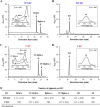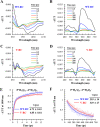The Photoactive Photosynthetic Reaction Center of a Rhodobacter sphaeroides Mutant Lacking 3-Vinyl (Bacterio)Chlorophyllide a Hydratase Contains 3-Vinyl Bacteriochlorophyll a
- PMID: 36971575
- PMCID: PMC10101016
- DOI: 10.1128/spectrum.03878-22
The Photoactive Photosynthetic Reaction Center of a Rhodobacter sphaeroides Mutant Lacking 3-Vinyl (Bacterio)Chlorophyllide a Hydratase Contains 3-Vinyl Bacteriochlorophyll a
Abstract
Rhodobacter sphaeroides mutant BF-lacking 3-vinyl (bacterio)chlorophyllide a hydratase (BchF)-accumulates chlorophyllide a (Chlide a) and 3-vinyl bacteriochlorophyllide a (3V-Bchlide a). BF synthesizes 3-vinyl bacteriochlorophyll a (3V-Bchl a) through prenylation of 3V-Bchlide a and assembles a novel reaction center (V-RC) using 3V-Bchl a and Mg-free 3-vinyl bacteriopheophytin a (3V-Bpheo a) at a molar ratio of 2:1. We aimed to verify whether a bchF-deleted R. sphaeroides mutant produces a photochemically active RC that facilitates photoheterotrophic growth. The mutant grew photoheterotrophically-implying a functional V-RC-as confirmed by the emergence of growth-competent suppressors of bchC-deleted mutant (BC) under irradiation. Suppressor mutations in BC were localized to bchF, which diminished BchF activity and caused 3V-Bchlide a accumulation. bchF expression carrying the suppressor mutations in trans resulted in the coproduction of V-RC and wild-type RC (WT-RC) in BF. The V-RC had a time constant (τ) for electron transfer from the primary electron donor P (a dimer of 3V-Bchl a) to the A-side containing 3V-Bpheo a (HA) similar to that of the WT-RC and a 60% higher τ for electron transfer from HA to quinone A (QA). Thus, the electron transfer from HA to QA in the V-RC should be slower than that in the WT-RC. Furthermore, the midpoint redox potential of P/P+ of the V-RC was 33 mV more positive than that of the WT-RC. R. sphaeroides, thus, synthesizes the V-RC when 3V-Bchlide a accumulates. The V-RC can support photoheterotrophic growth; however, its photochemical activity is inferior to that of the WT-RC. IMPORTANCE 3V-Bchlide a is an intermediate in the bacteriochlorophyll a (Bchl a)-specific biosynthetic branch and prenylated by bacteriochlorophyll synthase. R. sphaeroides synthesizes V-RC that absorbs light at short wavelengths. The V-RC was not previously discovered because 3V-Bchlide a does not accumulate during the growth of WT cells synthesizing Bchl a. The levels of reactive oxygen species increased with the onset of photoheterotrophic growth in BF, resulting in a long lag period. Although the inhibitor of BchF is unknown, the V-RC may act as a substitute for the WT-RC when BchF is completely inhibited. Alternatively, it may act synergistically with WT-RC at low levels of BchF activity. The V-RC may broaden the absorption spectra of R. sphaeroides and supplement its photosynthetic ability at various wavelengths of visible light to a greater extent than that by the WT-RC alone.
Keywords: 3-vinyl bacteriochlorophyll a; Rhodobacter sphaeroides; bchF mutation; reaction center.
Conflict of interest statement
The authors declare no conflict of interest.
Figures










Similar articles
-
Competitive inhibitions of the chlorophyll synthase of Synechocystis sp. strain PCC 6803 by bacteriochlorophyllide a and the bacteriochlorophyll synthase of Rhodobacter sphaeroides by chlorophyllide a.J Bacteriol. 2010 Jan;192(1):198-207. doi: 10.1128/JB.01271-09. J Bacteriol. 2010. PMID: 19880605 Free PMC article.
-
Engineered biosynthesis of bacteriochlorophyll gF in Rhodobacter sphaeroides.Biochim Biophys Acta Bioenerg. 2018 Jul;1859(7):501-509. doi: 10.1016/j.bbabio.2018.02.006. Epub 2018 Feb 26. Biochim Biophys Acta Bioenerg. 2018. PMID: 29496394
-
The photosystem of Rhodobacter sphaeroides assembles with zinc bacteriochlorophyll in a bchD (magnesium chelatase) mutant.Biochemistry. 2007 Oct 30;46(43):12491-500. doi: 10.1021/bi701407k. Epub 2007 Oct 2. Biochemistry. 2007. PMID: 17910480
-
Stereoselective C3-substituent modification and substrate channeling by oxidoreductase BchC in bacteriochlorophyll a biosynthesis.FEBS Lett. 2019 Apr;593(8):799-809. doi: 10.1002/1873-3468.13372. Epub 2019 Apr 4. FEBS Lett. 2019. PMID: 30908616
-
Structural and functional proteomics of intracytoplasmic membrane assembly in Rhodobacter sphaeroides.J Mol Microbiol Biotechnol. 2013;23(1-2):48-62. doi: 10.1159/000346520. Epub 2013 Apr 18. J Mol Microbiol Biotechnol. 2013. PMID: 23615195 Review.
References
-
- Struck A, Beese D, Cmiel E, Fischer M, Müller A, Schäfer W, Scheer H. 1990. Modified bacterial reaction centers: 3. Chemically modified chromophores at sites BA, BB and HA, HB, p 313–326. In Michel-Beyerle M-E (ed), Reaction centers of photosynthetic bacteria. Springer, Berlin, Germany.
LinkOut - more resources
Full Text Sources
Miscellaneous

